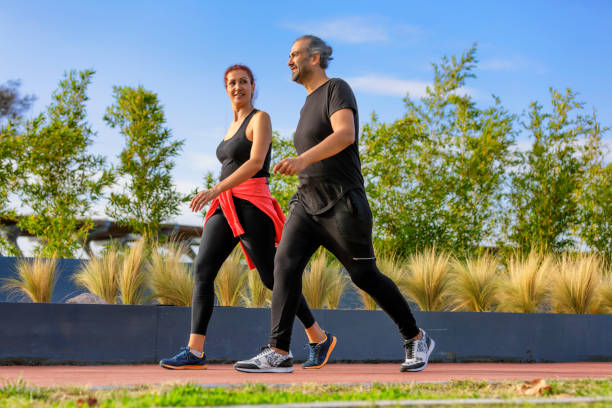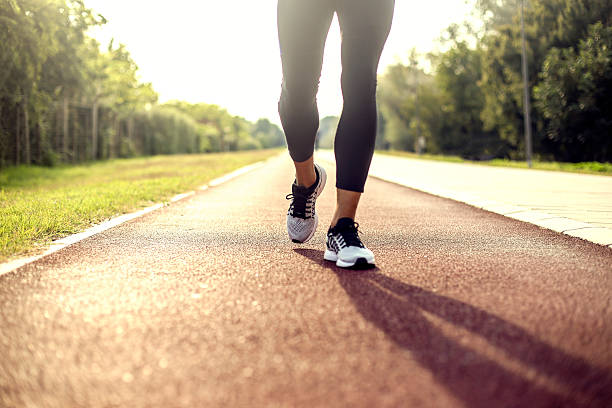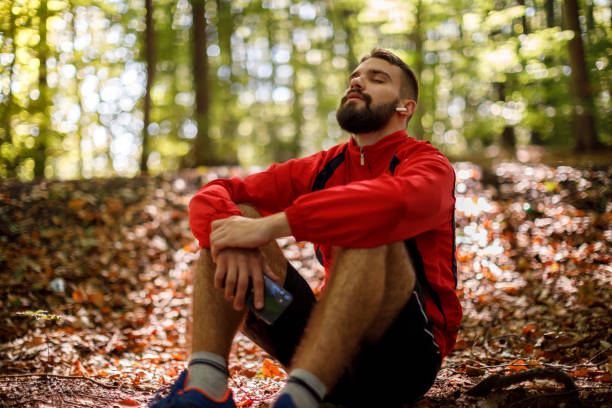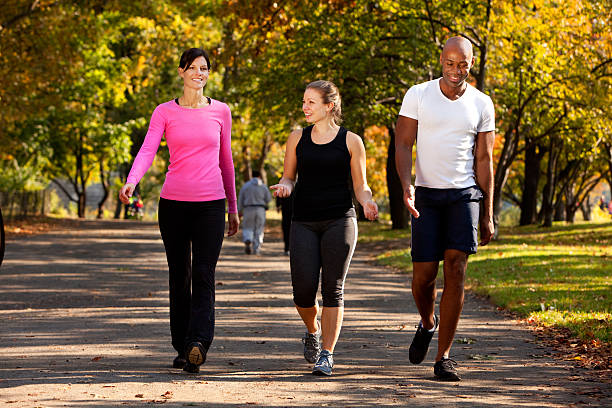
Walking for Mental Health: A Pathway to Peace and Wellness
As always, our goal is to consult the current evidence base to shed light on this topic. So, let’s get into it.
Finding peace, balance, calm, and relaxation can be challenging, particularly when we consider the daily stressors of modern life. The constant demands and pressures we face take a known toll on our mental well-being, leading to stress, anxiety, and depression.

While there is no single solution to mental health issues, one of the simplest and most accessible ways to improve our mental state is by walking. Most of the time, we don’t even think about walking. It’s often taken for granted, but in reality, intentional walking has the power to transform our mental health in so many positive ways.
In this blog post, we will explore the numerous benefits of walking for mental health and why incorporating walking into our daily routine can lead to a happier and more fulfilling life.
The Science of Walking and Mental Health

Walking may seem like a straightforward, mundane activity, but beneath its simplicity lies the fantastic goldmine of scientifically proven benefits for mental health.
As we walk, our brain releases endorphins, neurotransmitter hormones known as the body’s natural painkillers. In addition to relieving pain, they also create a general feeling of well-being. Endorphins interact with receptors in our brain, reducing pain perception and triggering positive feelings. These common effects make walking a natural mood booster, which helps alleviate symptoms of anxiety and depression.[1]
Moreover, walking also reduces the levels of stress hormones like cortisol, which play a significant role in stress management. Studies have shown that regular walking can reduce stress and promote relaxation, making it an excellent coping mechanism for everyday challenges, and adding meditation, such as focusing on steps instead of contemplating other life concerns, results in even greater stress reduction.[2]

Harvard Medical School recommends some form of exercise, such as 30-40 minutes of walking every day. They suggest at least two miles of walking per day. This can be done all at once or in shorter, cumulative chunks throughout the day with equal stress-reducing benefits.[3]
Regular aerobic exercise, like walking, both exhilarates and relaxes, stimulates and calms, and fights depression and stress.
Walking as a Mindfulness Practice

Mindfulness has gained popularity as a way to manage stress and also to enhance mental clarity.
A good working definition of mindfulness is when we choose to be fully aware and present in the current moment without judgement of the thoughts or feelings that tend to pull us out of that moment. That way, when we try to focus on the here and now but catch our thoughts drifting to that item that needs to make it on the grocery list or about next week’s important client meeting, we don’t beat ourselves up about it but, instead, simply refocus.
Walking can be used as a form of mindfulness practice. Practicing mindfulness while walking can be especially helpful for individuals who have not had luck with traditional meditation sessions because they find it challenging to sit still.
Often, mindfulness practice encourages focus on each breath. When walking, many find the practice of mindfulness is made easier by focusing on or counting steps.
As we work to focus on the present moment, with its myriad sensations, it is inevitable that the mind begins to wander. Mindfulness requires acknowledgment of this drifting followed by refocus of attention on the here and now. Counting breaths or steps provides an anchor for this attention.
A few structured mindfulness exercises recommended by The Mayo Clinic are:
Body Scan Meditation

Lying on your back with palms up and arms at your sides, focus your attention slowly on each part of your body, in order, from toe to head. Note the sensations, emotions, or thoughts associated with each part of your body.
Sitting Meditation

In a chair, sit with your back straight, feet on the floor, and hands in your lap. Breathe through your nose, and focus on your breath moving in and out of your body. If physical sensations or thoughts interrupt your meditation, note the experience and then return your focus to your breath.
And, of course, our favorite…Walking Meditation

Here, the Mayo clinic is basically recommending pacing. They suggest walking slowly for 10-20 feet, focusing on the experience of walking, and being aware of the sensations involved: standing, turning, and the subtle movements that help you maintain balance. At the end of the path, you then turn and repeat.[4]
Now, this can be adapted to a longer walk, and you can also count your steps as a way to stay focused.
When we walk mindfully, we can become fully present in the moment, focusing on each step, the feeling of our feet touching the ground, and the rhythm of our breath. Walking mindfully allows us to let go of intrusive thoughts about the past and future, fostering a sense of serenity that allows us to experience the sensations, awareness, and appreciation of being truly present.
Walking Provides a Connection with Nature

According to the World Health Organization, as of 2019, one in every eight people in the world live with a mental disorder, and more than 280 million people worldwide suffer from depression. They also estimate that, in 2020, these numbers increased by 26% for anxiety and 28% for depression.[5]
This means these disorders affect approximately one billion people worldwide.

Mental health problems result in poor outcomes for individuals and for society in general. These health issues are associated with lower quality of life, high economic and social cost, and increased mortality.
The healing power of nature is well-documented, and walking provides an opportunity to immerse ourselves in the beauty of the outside world. It doesn’t matter if it’s a stroll in a park, a hike through the woods, or a beachside walk, spending time in nature while walking has proven therapeutic effects for mental health.
The Japanese practice of shinrin-yoku, or forest bathing, involves engaging in activities in a forest environment to improve one’s health and well-being. Often, this is a physical activity, such as walking. However, walking can be paired with meditation, such as mindfulness practice, for additive mental health benefits.

Common treatments for depression are psychotherapy and antidepressants. While these are accessible treatment options and have proven benefits, they have distinct disadvantages as well. Antidepressants can cause nausea, diarrhea, weight gain, and other metabolic disturbances, and both antidepressants and psychotherapy are ineffective in the short term.[6]
A 2021 meta-analysis of the literature on nature-based activities and mental health showed that activities, such as walking in green spaces, improve mental health outcomes across all populations, including older adults with long-term conditions and those with common mental health problems. Additionally, this review showed that nature-based therapies, such as outdoor walking, have both a therapeutic effect for those with mental health issues as well as a preventative effect for healthy adults.[7]

It is clear that nature has a calming effect on the mind, reducing feelings of anxiety and depression. It helps to restore our attention and cognitive function, making us more focused and less prone to rumination. Walking in nature also offers a chance to disconnect from technology and the demands of daily life, promoting mental rejuvenation and a greater sense of well-being.
Walking for Social Interaction and Connection

Walking can be an ideal social activity, providing an opportunity to connect with friends, family, or join walking groups in the community. Engaging in conversations and sharing experiences while walking fosters a sense of belonging and support.
Humans are social beings, and social interaction is necessary for us to maintain good mental health. In short, we like to talk.

For those who may feel isolated or lonely, walking with a companion can alleviate feelings of loneliness and boost self-esteem. This is particularly true of older people who are at higher risk for depression due to adverse life events, like the loss of a spouse. Increasing exposure to walks in green areas has important mental health implications for this group.[8]
The camaraderie and encouragement that come with walking in pairs or groups can make the quest for better mental health more enjoyable and sustainable.

In addition to wide-ranging health benefits, walking groups have high levels of adherence and low attrition rates with virtually no adverse effects.[9] So, if you want to meet new people or solidify existing relationships, walking is a fantastic avenue that can help you meet those goals, while also improving both your mental and physical health.
Walking to Improve Sleep and Mental Health

Adequate sleep reduces the risk of diabetes and cardiovascular disease, improves cognition, and reduces mortality. Good sleep also improves mental health by lowering depression risk. 7-8 hours of sleep per night is recommended for both adults and older adults.[10] Clearly, sleep plays a vital role in mental health, and walking can contribute to better sleep patterns.

Regular physical activity, including walking, has been associated with improved sleep quality and duration. Walking helps to regulate circadian rhythms and tire the body naturally, making it easier to fall asleep and experience restful nights. [11]
Walking for Empowerment and a Sense of Achievement

Physical inactivity accounts for 9% of all deaths worldwide, and nearly half of people over age 60 are sedentary.[12] Embarking on a walking routine, whether it’s local strolls around town or challenging difficult mountain trails, empowers individuals to take charge of both their physical and mental health. Achieving walking goals, small or large, can give us a sense of accomplishment and boost our self-confidence.
Setting and achieving walking goals can create a positive feedback loop. As you see the benefits of walking on your mental well-being, you can become motivated to continue and explore new ways to challenge yourself both physically and mentally.
Walking as a Coping Strategy

We all need healthy coping strategies to navigate through the challenges life throws our way. These healthy coping strategies protect us from self-destructive pathways, such as self-medicating with drugs or alcohol or other damaging pursuits. Walking can be an effective coping mechanism for dealing with stress, grief, and other emotional difficulties, such as depression. It can also be used as a preventative strategy to head off these mental health issues.[13]
When faced with overwhelming emotions, going for a walk can offer a much-needed break from mental pain and chaos, resulting in lower mental distress.[14] A change of scenery coupled with physical exertion can help us gain perspective and clarity. Walking can also serve as a way to release pent-up energy and tension, making for a cathartic experience that sends us on a new and better mental path.
Conclusion

Walking is more than a physical activity. It is a holistic approach to nurturing our mental health. The benefits of walking extend far beyond weight loss and improved fitness by profoundly impacting our emotional and psychological well-being. In a world where stress and mental health issues are prevalent, every step you walk brings you closer to a healthier, happier you.
References:
[1] Harvard Medical School, Endorphins: The brain’s natural pain reliever, 2021, July 20. Harvard Health Publishing. health.harvard.edu. Retrieved August 9, 2023, from https://www.health.harvard.edu/mind-and-mood/endorphins-the-brains-natural-pain-reliever
[2] North Dakota State University, Walking Can Help Relieve Stress, Extension and Ag Research News, 2011, August 8, ag.ndsu.edu. Retrieved August 1, 2023, from https://www.ag.ndsu.edu/news/newsreleases/2011/aug-8-2011/walking-can-help-relieve-stress/
[3] Harvard Medical School, Exercising to relax, 2020, July 7. Harvard Health Publishing. health.harvard.edu. Retrieved August 9, 2023, from https://www.health.harvard.edu/staying-healthy/exercising-to-relax
[4] The Mayo Clinic, Mindfulness Exercises, 2022, October 11, mayoclinic.org. Retrieved August 9, 2023, from https://www.mayoclinic.org/healthy-lifestyle/consumer-health/in-depth/mindfulness-exercises/art-20046356#:~:text=Mindfulness%20is%20a%20type%20of,mind%20and%20help%20reduce%20stress
[5] World Health Organization. Mental Disorders. 2022, June 8, who.int. Retrieved August 9, 2023 from https://www.who.int/news-room/fact-sheets/detail/mental-disorders
[6] Rosa, C, et al. Forest therapy can prevent and treat depression: Evidence from meta-analyses. 2021, January, sciencedirect.com. Retrieved August 9, 2023 from https://www.sciencedirect.com/science/article/abs/pii/S1618866720307603
[7] Coventry, P, et al. Nature-based outdoor activities for mental and physical health: Systematic review and meta-analysis. 2021, October 1, sciencedirect.com. Retrieved August 9, 2023 from https://doi.org/10.1016/j.ssmph.2021.100934
[8] Roe J, Mondschein A, Neale C, Barnes L, Boukhechba M and Lopez S (2020) The Urban Built Environment, Walking and Mental Health Outcomes Among Older Adults: A Pilot Study. Front. Public Health 8:575946. doi: 10.3389/fpubh.2020.575946
[9] Hanson S, et al. Is there evidence that walking groups have health benefits? A systematic review and meta-analysis. Br J Sports Med 2015;49:710–715. doi:10.1136/bjsports-2014-094157
[10] Chaput, JP, et al. Sleep duration and health in adults: an overview of systematic reviews. Applied Physiology, Nutrition, and Metabolism, 2020, October 15, https://doi.org/10.1139/apnm-2020-0034
[11] Sullivan Bisson, A, et al. Walk to a Better Night of Sleep: Testing the Relationship Between Physical Activity and Sleep, Sleep Health. 2019 Oct; 5(5): 487–494. Published online 2019 Jul 26. doi: 10.1016/j.sleh.2019.06.003
[12] Franco, M, et al. Older people’s perspectives on participation in physical activity: a systematic review and thematic synthesis of qualitative literature. Br J Sports Med. 2015 Oct;49(19):1268-76. doi: 10.1136/bjsports-2014-094015
[13] Kelly, P., Williamson, C., Niven, A., Hunter, R., Mutrie, N., & Richards, J. (2018). Walking on sunshine: scoping review of the evidence for walking and mental health. British Journal of Sports Medicine, 52(12), 800-806. DOI:10.1136/bjsports-2017-098827
[14] Mau, M.; Aaby, A.; Klausen, S.H.; Roessler, K.K. Are Long-Distance Walks Therapeutic? A Systematic Scoping Review of the Conceptualization of Long-Distance Walking and Its Relation to Mental Health. Int. J. Environ. Res. Public Health 2021, 18, 7741. https:// doi.org/10.3390/ijerph18157741




One Comment
https://wwd.com/
This is the perfect webpage for anybody who hopes to understand this topic.
You realize a whole lot its almost hard to argue with you (not that
I actually will need to…HaHa). You definitely put a new spin on a subject that’s been discussed for years.
Excellent stuff, just great!